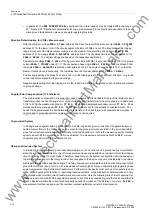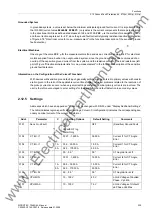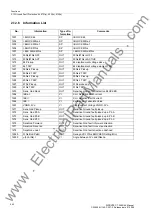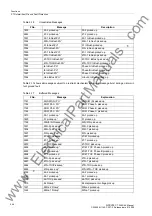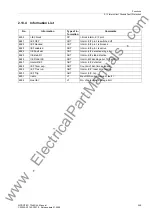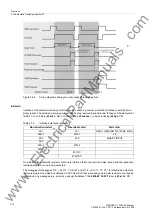
Functions
2.13 Intermittent Ground Fault Protection
SIPROTEC, 7SJ62/64, Manual
C53000-G1140-C207-2, Release date 01.2008
247
Before they are entered in the fault log (event buffer) and transmitted to the system interface or CFC, the mes-
sages of Table 2-17 are buffered (starting with the first pickup message received after
„Intermitt.EF“
was
signaled). The buffering does not apply for signaling to relays and LEDs as it is required by time-graded pro-
tection systems for reverse interlocking. The buffer can store a maximum of two status changes (the most
recent ones) for each message.
Buffered messages are signaled to the fault log, CFC and to the system interface with the original time flag only
when a TRIP command is initiated by a protection function other than the intermittent ground fault protection.
This ascertains that a pickup, although delayed, is always signaled in association with each TRIP command.
All pickup messages which usually do not occur during an intermittent ground fault are not affected by this
mechanism. Among others this includes the pickup and TRIP commands of the following protective functions:
• Breaker failure protection,
• Overload protection,
• Frequency protection and
• Voltage protection.
The pickup signals of these functions will still be logged immediately. A TRIP command of one of these pro-
tective functions will cause the buffered messages to be cleared since no connection exists between tripping
function and buffered message.
A fault event is cleared when the time
T-reset
has expired or the TRIP command
„IEF Trip“
has been
terminated.
Terminating a fault event for the intermittent ground fault protection thus is a special case. It is the time
T-
reset
that keeps the fault event opened and not the pickup.
2.13.2
Setting Notes
General
The protection function for intermittent ground faults can only take effect and is only accessible if the current to
be evaluated (
133
,
INTERM.EF
or
with Ignd
) was configured in address
with 3I0
with Ignd,sens.
.
If not required, this function is set to
Disabled
.
The function can be turned
ON
or
OFF
under address
3301
INTERM.EF
.
The pickup threshold (r.m.s. value) is set in address
3302
Iie>
. A rather sensitive setting is possible to
respond also to short ground faults since the pickup time shortens as the current in excess of the setting in-
creases. The setting range depends on the selection of the current to be evaluated at address
133
INTERM.EF
.
The pickup time can be prolonged at address
3303
T-det.ext.
. This pickup stabilization is especially impor-
tant for the coordination with existing analog or electromechanical overcurrent relays. The time
T-det.ext.
can also be disabled (
T-det.ext.
= 0).
The stabilized pickup starts the counter
T-sum det.
. This counter is stopped but not reset when the picked
up function drops out. Based on the last counter content the counter resumes counting when the stabilized
function picks up next. This sum of individual pickup times, which are to initiate tripping, is set at address
3304
T-sum det.
. It represents one of the four selectivity criteria (pickup value
Iie>
, detection extension time
T-
det.ext.
, counter
T-sum det.
and reset time
T-reset
) for coordinating the relays on adjacent feeders
and is comparable to the time grading of the time overcurrent protection. The relay in the radial network which
is closest to the intermittent fault and picks up, will have the shortest summation time
T-sum det.
.
1227
„51Ns Pickup“
51Ns picked up
6823
„START-SUP pu“
Startup supervision Pickup
FNo.
Message
Explanation
www
. ElectricalPartManuals
. com






